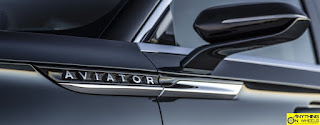Variant Tested: 1.5L Petrol AT (Titanium +)
When the EcoSport was launched in 2013, it's funky styling, feature-loaded interiors and a host of powertrain options (including the pint-sized, award-winning 1.0-liter ‘EcoBoost’ engine) made it a hot property in the market. Waiting periods stretching for 6 to 9 months wasn’t uncommon. But with rivals Maruti-Suzuki, Honda and recently Tata catching up, Ford’s big-seller started feeling long in the tooth.
Not wanting to bow without a fight in a segment it pioneered, Ford gave the EcoSport a fairly comprehensive facelift recently. The fascia is revised, the feature list has been spruced up and there's an all-new petrol engine under the hood paired with a new 6-speed automatic transmission. Are these changes enough to keep the EcoSport going amidst an onslaught from newer rivals? With the diesel engine remaining unchanged, we take the top-end petrol automatic variant (Yes, there’s one!) for a spin to find out.
Looks & Styling
That the EcoSport created quite a stir when it was first seen on Indian roads would be an understatement. Fiddling with a formula that worked so well would be a crime and Ford has rightly decided against it. Yet, this is more than what most facelifts offer these days.

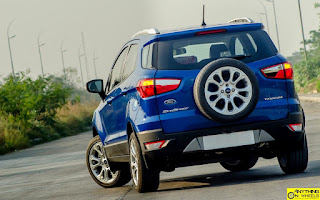
For starters, the fascia is all-new. A larger one-piece trapezoidal grille takes center stage with a liberal dosage of chrome that Indians have fallen in love with. The headlights have grown in size too and now get inbuilt projectors for better illumination. New LED Daytime Running Lights replace the functional-but-boring foglamp-mounted halogen bulbs from the pre-facelift models. The foglamps and indicators, both a tad too big for our liking, are housed in more prominent enclosures. The bumper gets more body-coloured elements than before, suiting the urban crossover role the EcoSport and its rivals have become synonymous with. With all these changes, Ford's smallest crossover has now gained the 'family look', in line with the brand's bigger global SUVs like the Escape and Edge.
With such extensive changes up front, one would obviously expect a similar treatment to the rest of the vehicle. Sadly, that’s not the case. In fact, the only change in profile are the alloy wheels that wear a new design with the top-end Titanium + variant shod with 17-inch wheels. Yes, they look fabulous with those thin side-walls but their longevity on our pothole-ridden roads is a big question mark.
Nothing has changed at the rear, not even the design of the taillight lenses which are the first ones to go under the knife during a facelift. The tailgate, like before, is hinged on its left and opens the wrong way for a right-hand drive market like ours. Unlike the international models, Ford has retained the tailgate-mounted spare wheel for the domestic market. So, the butch SUV look that the mass market craves for is still intact!
The only other noteworthy change we could spot were the new request sensors on the front doors. The cheap black plastic buttons are now gone, replaced by classy inbuilt sensors that unlock automatically when you get close to the door with the key in your pocket and lock with a gentle touch on the three ribs on the door handle.
Interiors
When the EcoSport went on sale five years back, it was easily the most feature-loaded and tech-laden car you could buy this side of 10 Lakh Rupees. But the dashboard, with a plethora of buttons inspired by old Nokia mobile phones, was a hit or a miss. Some liked it while some - like us - found the design and layout dated. The new EcoSport have folks like us covered.

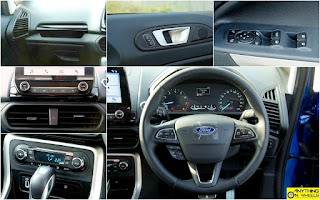
The dashboard gets a new design and layout that's far superior to the outgoing model. The all-black cabin replaces the grey and black theme adopted earlier, albeit with silver and piano black bits used here and there to liven things up. The steering wheel, control stalks and instrument cluster are all-new, the center console has been redesigned with a funky 8.0-inch ‘floating’ touchscreen stuck on to it and the climate control buttons and knobs are now shared with the Figo and Figo Aspire. Build quality, though not outstanding, is not bad while fit and finish has improved quite a bit over its predecessor. That said, certain ungainly bits could still be seen here and there.
The tilt and telescopic steering wheel has a healthy adjustment range to suit your driving position. The seats themselves offer good support unless you are someone with a heavy build. Lumbar adjustment, a very useful feature for those with a delicate back, has been inexplicably given a miss in the facelift. Headroom is excellent while legroom and shoulder room are more than adequate. At the rear, things are comfortable as long as the bench is occupied by two passengers. Bring in a third occupant and the seat's narrow width and tall central tunnel make things tough.
Boot space is comparable to rivals and the EcoSport offers split-folding rear seats for those occasions when you need additional space to stuff things in. There's also an unique height-adjustable boot floor which, when placed in its highest position, forms a perfectly flat loading bay with the rear seat folded.
Steering Wheel & Instrument Cluster
The all-new steering wheel not just looks good but feels great to hold as well with perfectly-shaped thumb recesses. Wrapped in soft leather that feels premium to the touch, the steering wheel has buttons for audio controls, voice commands and BlueTooth telephony on the right and toggle buttons for the MID (Multi Information Display) to its left. Switches for the cruise control are located below the left spoke while paddle shifters for moving up and down the gears are placed right behind. Classy Euro-inspired control stalks are chunky to hold and solid to operate.


If there is one aspect of the facelifted EcoSport that we wish Ford hadn't changed, it has got to be the instrument cluster. With a plain black screen housing a tachometer to its left and speedometer to its right, the design lacks flair and any sort of ornamentation. The tiny MID screen - one of the smallest we have seen in recent times - and the big empty space around it look awful and the display font is outdated. What it lacks in visual flair, the screen gains with its content. Apart from the regular odo, trip, fuel efficiency and distance to empty readouts, the cluster also has a cheeky digital speedo, an useful tire pressure monitor and the ability to control a host of vehicle settings including cruise control, driver assist features and headlamp and wiper settings.
Infotainment System
Tablet-like floating touch screens are in vogue these days and Ford is one of the many car-makers that have adopted this across the range. Occupying prime real estate in the center console is an 8.0-inch touchscreen that controls the infotainment system as well as other vehicle functions.
Fluid to the touch with almost zero lag and a crystal clear display, the EcoSport's SYNC 3.0 infotainment system is terrific and easily the best in the segment. In fact, one of us found the touchscreen to be as responsive and intuitive to use as a modern mid-range smartphone. Connectivity is through BlueTooth and USB with Aux-in no longer an option. Featuring voice commands and Wi-Fi connectivity, the system also supports Apple CarPlay and Android Auto with navigation. Sound quality is above average with 5 speakers and 2 tweeters doing their job pretty well.

In addition to the usual audio settings and controls for BlueTooth telephony, the SYNC 3.0 system lets us fiddle with a host of other settings including that of Emergency Assistance that dials 108 automatically in case of an accident and Valet Mode which lets us lock the system through a 4-digit pin when handing over the car to a valet. Its also compatible with Ford's AppLink that allows the system to access certain apps from the connected smartphone like Spotify, Inshorts, AccuWeather and Map My India. A thoughtful feature is the presence of physical buttons for frequently used functions thereby eliminating the need for taking your eyes off the road.
Engine & Transmission
Not often in mid-cycle facelifts like these do you see the powertrain lineup changing. Ford throws that perception out of the window by debuting its brand new "Dragon" engine under the hood of the EcoSport facelift. This new 3-cylinder naturally-aspirated petrol engine replaces the 1.0-liter EcoBoost turbo petrol and the 1.5-liter Sigma TiVCT petrol engines that powered the outgoing model. The 1.5-liter diesel engine continues without any change.
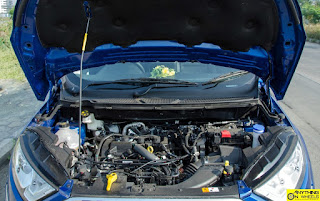
Generating 121 horsepower and a peak torque of 150 Nm, the EcoSport petrol looks good on paper. Compared to the outgoing 4-cylinder engine, Ford claims a 10% increase in power and a 7% increase in torque while consuming 7% less fuel and emitting 7% less emissions. Press the Power button on and the initial signs are positive. Apart from a shaky start and a mild clatter at idle, there is none of those tantrums on the move you would normally associate with a small 3-cylinder mill. Ford's engineers have used balancer shafts supported by hydrodynamic bearings as well as a timing belt that's dipped in oil to reduce friction and harshness. There's also a full-on acoustic isolation system to keep vibrations in check. Get going and the Dragon's linear power delivery and superb bottom-end makes the EcoSport a joy to drive in the city. Show the car an open road and the engine is happy to keep revving and deliver the power you ask from it.
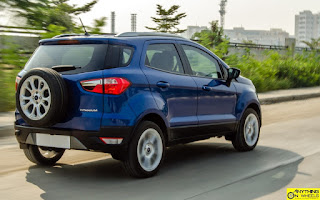
Mated to the engine is either a 5-speed manual or the 6-speed automatic transmission that we drove. The latter is a new torque converter unit that replaces the advanced but less reliable dual clutch automatic gearbox. Put the stick in 'D' mode and the shifts are smooth, seamless and almost unnoticeable. Move it to 'S' and the gearbox puts on its boost mode, holding gears that much longer before shifting up. For the enthusiasts amongst us, paddle shifters are available. With the stick in S and the manual mode enables, the EcoSport is quite a fun machine. In fact, in the picture below, you could see the engine screaming at 5,000 rpm in second gear with the car doing a brisk 80 km/h!
Thanks to such enthusiastic driving, the car returned a modest 12.0 km/l during our drive that consisted of a mix of stop-start driving and occasional bursts on open roads.
Ride & Handling
One of the biggest downers of the outgoing EcoSport, especially in the top-end Titanium + trim level that were equipped with 16-inch wheels, is its bumpy ride quality. Ford has responded to it and the result is a slightly better ride quality despite being shod with skinny 17-inch tires. The lower variants - fitted with 15-inch wheels - show a remarkable improvement in ride quality with an underlying softness that was missing all this while. That said, the McPherson struts up front and the semi-independent twist beam at the rear still let bumps and potholes filter into the cabin at slow speeds. Though the ride improves as you gather speed, the EcoSport is still not a car you would drive over a broken piece of tarmac without slowing down.
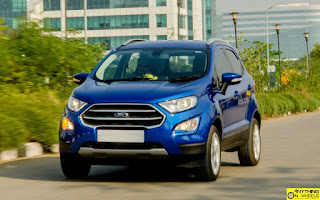

The best part is the EcoSport has lost none of its dynamic prowess in pursuit of ride quality. The 205/50 R17 tires are sufficiently grippy and the car maintains poise and composure irrespective of the conditions. Straight line stability is superb and the car does not get jittery at the twist of your finger. Speaking of which, the Electric Power Steering in the EcoSport is super light to use at parking speeds but weighs up as speeds build up. Be it sudden direction changes or late lane switches, turn the wheel and the EcoSport darts in confidently and makes you smile. The EcoSport remains the top choice if 'fun behind the wheel' is what you are looking for.
Safety
Ford has been a pioneer when it comes to offering safety features in the mass-market segments. Equipped to the gills with Antilock Braking System, Electronic Brakeforce Distribution, Traction Control System, Emergency Assistance and as much as six airbags, the EcoSport is the flag-bearer for safety in its segment.
Moreover, the car is 4-star certified in the Euro NCAP crash tests, albeit in its previous avatar. Other cars in the price range, including its rivals Vitara Brezza and Nexon, have not been crash tested yet and offer a maximum of two airbags.
Verdict
The EcoSport was a strong competitor even before the facelift, fending off much-newer rivals like Maruti-Suzuki's Vitara Brezza, Honda's WR-V and Tata's Nexon. At best, all it needed was a nip and tuck externally and a touch-screen inside. By virtue of bringing in such a comprehensive facelift complete with an all-new engine and transmission, Ford has not just responded to what the market demanded but also ensured the EcoSport remains the best compact SUV on sale. The Vitara Brezza might be the top-seller in this space but you know who leads the race when it comes to all round capability.
Photography: Bharath Rengaraj
Content & Editing: Aravind Ramesh








